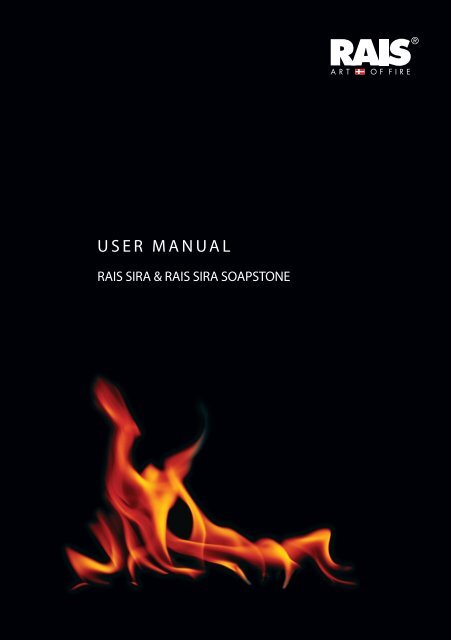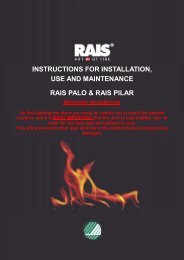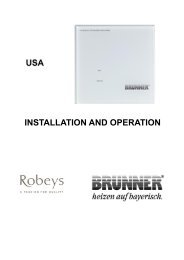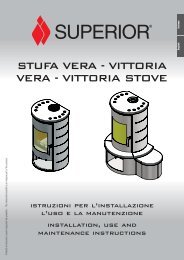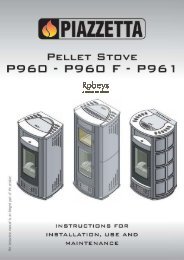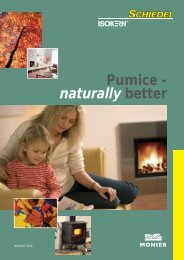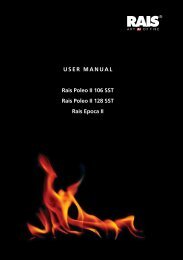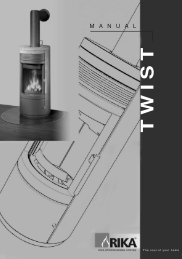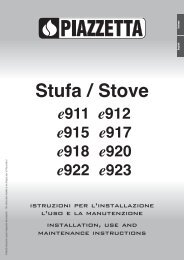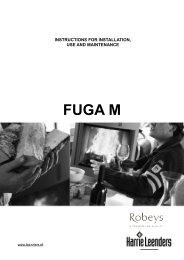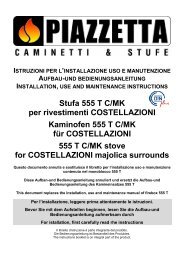Rais Sira Installation, Use and Maintenance Manual - Robeys Ltd
Rais Sira Installation, Use and Maintenance Manual - Robeys Ltd
Rais Sira Installation, Use and Maintenance Manual - Robeys Ltd
- No tags were found...
Create successful ePaper yourself
Turn your PDF publications into a flip-book with our unique Google optimized e-Paper software.
ENGLISHRAIS - manual for SIRA & SIRA SOAPSTONEUSER MANUALRAIS SIRA & RAIS SIRA SOAPSTONE1
ENGLISH RAIS - manual for SIRA & SIRA SOAPSTONE<strong>Rais</strong> <strong>Sira</strong><strong>Rais</strong> <strong>Sira</strong> soapstoneModified : 3Dato : March 2008We cannot be held responsible for any misprintsINTRODUCTION ................................................................................................................................................................................. 4WARRANTY........................................................................................................................................................................................... 4SPECIFICATIONS ................................................................................................................................................................................ 5CONVECTION ..................................................................................................................................................................................... 6INSTALLATION INSTRUCTION........................................................................................................................................................ 7CHIMNEY .......................................................................................................................................................................................... 8-9INSTALLATION...................................................................................................................................................................................10ADJUSTMENT OF CHIMNEY CONNECTION...................................................................................................................... 11-12INSTALLATION OF SOAPSTONE ..................................................................................................................................................13INSTALLATION DISTANCE IN CASE OF COMBUSTIBLE WALL..................................................................................... 14-15GENERAL INSTALLATION (RIGHT ANGLE) SECURE BASE ...................................................................................................15CORNER INSTALLATION 45° .............................................................................................................................................15INSTALLATION DISTANCE IN CASE OF NON-COMBUSTIBLE WALL.................................................................................15FOR THE INSTALLER.........................................................................................................................................................................16OPERATING INSTRUCTION............................................................................................................................................................18FUEL ............................................................................................................................................................................................. 18-19DRYING AND STORAGE .................................................................................................................................................................19REGULATION OF COMBUSTION AIR .........................................................................................................................................20USING THE WOOD BURNING STOVE .......................................................................................................................................21ADJUSTMENT OF AIR DAMPER ..........................................................................................................................................21CONTROL ...........................................................................................................................................................................................21FIRST USAGE ....................................................................................................................................................................................22LIGHTING AND FUELLING...................................................................................................................................................... 24-25CLEANING AND CARE ...................................................................................................................................................................26CLEANING OF THE FLUE WAYS....................................................................................................................................................27INTERRUPTION OF OPERATION .................................................................................................................................................28ACCESSORIES AND SPARE PARTS...............................................................................................................................................30SPARE PARTS DIAGRAM ......................................................................................................................................................... 30-313
RAIS SIRA RAIS SIRASOAPSTONENominal outputt (kW): 5 5Min./Max. output (kW): 2-6 2-6Recommended amount of wood when fuelling (kg):(Distributed on 2-3 logs of wood of approx. 25 cm)1,7 1,7Min. uptake / Min. draught (Pascal): -11 -11Weight (kg): 145 225Smoke gas temperature (°C): 259 259ENGLISHIntroductionRAIS - manual for SIRA & SIRA SOAPSTONEENGLISH RAIS - manual for SIRA & SIRA SOAPSTONESpecificationsThank you for purchasing a RAIS wood burning stove. In the UK the stove has beenapproved by HETAS <strong>Ltd</strong> as an intermittent operating appliance for burning wood logsonly.Intermittent operation: Fuelling should be undertaken within 3 hoursA RAIS wood burning stove is more than just a heat source: it also shows that you careabout design <strong>and</strong> quality in your home.Stove’s width/depth/height (mm): 504-408-960 551-438-1000Combustion chamber’s width/depth/height(mm): 372-238-300 372-238--300Heating area l(m 2 ): ca. 80 ca. 80Smoke gas mass flow (g/s): 5,99 5,99To make the most of your wood burning stove it is important that you read the manualthoroughly, before installation <strong>and</strong> use.In the case of warranty coverage, <strong>and</strong> for general queries regarding your wood burningstove, it is important that you know the stove’s production number.We therefore recommend that you note down the number in the table below. The productionnumber is located on the back of the stove at the bottom.WarrantyYour RAIS wood burning stove comes with a 5 year warranty. The warranty, however,does not cover heat-insulating materials, glass <strong>and</strong> seals.Any alterations made to the stove will void the warranty.Distributor:Date:45
ENGLISHConvectionRAIS - manual for SIRA & SIRA SOAPSTONERAIS stoves are convection stoves. This means that the stove’s back <strong>and</strong> side panels arenot over-heated. Convection means that there is a circulation of air, which ensures thatthe heat is distributed more evenly throughout the entire room. The cold air is drawn inat the base of the stove up through the convection channel, which runs along the stove’scombustion chamber. The heated air pours out at the top of the stove, which ensures acirculation of warm air throughout the room.The stoves are equipped with a “cold” lever – RAIS special feature – which means youcould almost do away with gloves. Be aware, however, that all exterior surfaces becomehot during use - so take extreme care.ENGLISH RAIS - manual for SIRA & SIRA SOAPSTONE<strong>Installation</strong> instructionsThe following pages give instructions for the safe <strong>and</strong> proper installation of this heating appliancein the UK. These instructions cover the basic principles of installation, although detailmay need slight modification to suit particular local site conditions. In all cases the installationmust comply with current UK Building Regulations, Local Authority Byelaws <strong>and</strong> otherspecifications or regulations as they affect the installation of the stove. Please note that it is alegal requirement under Engl<strong>and</strong> <strong>and</strong> Wales Building Regulations that the installation of thestove is either carried out under Local Authority Building Control approval or is installed bya Competent Person registered with a Government approved Competent Persons Scheme.HETAS <strong>Ltd</strong> operate such a Scheme <strong>and</strong> a listing of their Registered Competent Persons canbe found on their website at www.hetas.co.uk.It should be noted that the current Building Regulations requirements are given in ApprovedDocument J. These requirements may also be met by adopting the relevant recommendationsgiven in British St<strong>and</strong>ards BS 8303, BS 6461 <strong>and</strong> BS 7566.WARNING: Health <strong>and</strong> Safety Advice NoticeThe installation of this heating appliance is governed by the Health <strong>and</strong> Safety at Work Act1974. It is the responsibility of the installer to ensure that all requirements of this Act are metduring the installation works. Attention is drawn in particular to the following:H<strong>and</strong>ling:The appliance is a heavy item <strong>and</strong> adequate facilities must be available for loading,unloading <strong>and</strong> site h<strong>and</strong>ling.Fire Cement:Some types of fire cement are caustic <strong>and</strong> should not be allowed to come into contactwith the skin. Protective gloves should be worn when h<strong>and</strong>ling fire cement. In case ofcontact with the skin wash immediately with plenty of water.Asbestos:This stove contains no asbestos. If there is a possibility of disturbing any asbestos inthe course of installation then please seek specialist guidance <strong>and</strong> use appropriateprotective equipment.Metal Parts:When installing or servicing this stove care should be taken to avoid the possibility ofpersonal injury.Important Warning –Preparatory Work <strong>and</strong> Safety Checks:• This stove must not be installed into a chimney that serves any other heating appliance.• There must not be an extractor fan fitted in the same room as the stove as this can causethe stove to emit fumes into the room.• If this appliance is installed into an existing chimney, the chimney must first be swept<strong>and</strong> examined for soundness <strong>and</strong> suitability before the appliance is installed (see alsosection headed “Chimney”).67
ENGLISH RAIS - manual for SIRA & SIRA SOAPSTONEChimneyThe chimney is the driving force which makes the stove function. In order for the stove toperform satisfactorily the chimney height must be sufficient to ensure the correct draughtof 14 to 18 Pa so as to clear the products of combustion <strong>and</strong> prevent problems of smokeemanating into the room when firing.NOTE: A chimney height of not less than 4.5 metres measured vertically from the outletof the stove to the top of the chimney should be satisfactory. Alternatively the calculationprocedure given in BS 5854:1980 may be used as the basis for deciding whether a particularchimney design will provide sufficient draught.The outlet from the chimney should be above the roof of the building in accordance with theprovisions of Building Regulations Approved Document J.If installation is into an existing chimney then it must be sound <strong>and</strong> have no cracks or otherfaults which might allow fumes into the house. Older properties, especially, may have chimneyfaults or the cross section may be too large i.e. more than 230 mm x 230 mm. Remedialaction should be taken, if required, seeking expert advice, if necessary. If it is found necessaryto line the chimney then a flue liner suitable for solid fuel must be used in accordance withBuilding Regulations Approved Document J.ENGLISH RAIS - manual for SIRA & SIRA SOAPSTONEIf it is found that there is excessive draught in the chimney then either an adjustable fluedamper or alternatively a draught stabiliser should be fitted. The adjustable flue dampershould not close off the flue entirely but should in its closed position leave a minimumcontinuous opening free area of at least 20 % of the total cross sectional area of the flue orfluepipe.Adequate provision e.g. easily accessible soot door or doors must be provided for sweepingthe chimney <strong>and</strong> connecting fluepipe.You should also familiarise yourself with the draught conditions for chimneys with 2 flues.The flue outlet spigot is 150 mm in diameter.For strong draughts, the chimney or flue should be fitted with a draught stabiliser. In whichcase, it is important to ensure that there is a free flow-through area of minimum 20 cm² whenthe regulating gate is shut. Otherwise, the fuel energy may not be used optimally. If, at anytime, you are unsure about the condition of the chimney, you should contact a chimneysweep.Remember that access to the access door should be kept clear.Any existing chimney must be clear of obstruction <strong>and</strong> have been swept clean immediatelybefore installation of the stove. If the stove is fitted in place of an open fire then the chimneyshould be swept one month after installation to clear any soot falls which may have occurreddue to the difference in combustion between the stove <strong>and</strong> the open fire.If there is no existing chimney then either a prefabricated block chimney in accordance withBuilding Regulations Approved Document J or a twin walled insulated stainless steel flue toBS 4543 can be used. These chimneys must be fitted in accordance with the manufacturer’sinstructions <strong>and</strong> Building Regulations.A single wall metal fluepipe is suitable for connecting the stove to the chimney but is notsuitable for using for the complete chimney. The chimney <strong>and</strong> connecting fluepipe musthave a minimum diameter of 150 mm <strong>and</strong> its dimension should be not less than the size ofthe outlet socket of the stove which is 150 mm in diameter. Any bend in the chimney or connectingfluepipe should not exceed 45°. 90°bends should not be used.Combustible material should not be located where the heat dissipating through the wallsof fireplaces or flues could ignite it. Therefore when installing the stove in the presence ofcombustible materials due account must be taken of the guidance on the separation ofcombustible material given in Building Regulations Approved Document J <strong>and</strong> also in thesestove instructions.89
ENGLISHRAIS - manual for SIRA & SIRA SOAPSTONEProducentRAIS A/S, Industrivej 20, 9900 Frederikshavn, Danmark06EN 13240:2001+A2:2004 EC.nr. 306Anordning til intervalfyringSIRA / SIRA SSTAfst<strong>and</strong> til brændbart, bagvæg: 200 mm<strong>Sira</strong> Manufacturer’s PlateENGLISH RAIS - manual for SIRA & SIRA SOAPSTONEAdjustment of chimney connectionThe stove is always delivered for top connection, but can be changed to rear connectionas follows:Remove the baffle plate <strong>and</strong>the smoke chicane.(see cleaning <strong>and</strong> care)Afst<strong>and</strong> til brændbart, sidevægCO emissionRøggas temperaturNominel effektVirkningsgradBrændsel (Brug kun anbefalede brændsler)Følg instrukserne i brugermanualen.Anordningen er egnet til røggassamleledningSINTEFProduktdokumentation: 250 mm: 0,16 %: 259 °C: 5 kW: 77 %: træ043-117Disassemble the backpanel <strong>and</strong> reflector plate.<strong>Installation</strong> It is prohibited to carry out unauthorised alterations to the stove.There must be plenty of fresh air in the room where the stove is being installed, in order toensure proper combustion. Note that any mechanical exhaust ventilation - e.g. an extractionhood - may reduce the air supply. Any air grates must be placed in such a manner, that theair supply is not blocked.Loosen the 3 M6 nuts with a wrench key.Building Regulations Approved document J gives specific guidance on the requiredpermanent ventilation into the room for combustion air of solid fuel appliances.The floor structure must be able to carry the weight of the wood burning stove, as well as theweight of a chimney, if necessary.When you choose where to set up your RAIS wood burning stove, you should consider theheat distribution to the other rooms. This will enable you to get the best use out of yourstove. The stove should be set up at a safe distance from inflammable materials. See themanufacturer’s plate on the wood burning stove.Remove protective cover <strong>and</strong> seal <strong>and</strong> place over the holeon the top - make sure that the seal is positioned properly.Tighten the assembly using the 3 M6 nuts.1011
ENGLISHRAIS - manual for SIRA & SIRA SOAPSTONEThe flue outlet spigot, which you will find in a pouch inthe stove, <strong>and</strong> the holder for the upper flue diverter areassembled with 3 M6x20 head cap screws <strong>and</strong> M6 nuts.The smoke leader <strong>and</strong> baffelplate are assembled in reverseorder.ENGLISH RAIS - manual for SIRA & SIRA SOAPSTONE<strong>Installation</strong> of soapstoneList of materials (individual components for assembling soapstone)Item number Product designation Number3067001/3067002 Top plate without hole/Top plate with hole3067006 Sidestone 13060603 Top screw 32Assemble the reflector plate <strong>and</strong> backpanel.1213
ENGLISH RAIS - manual for SIRA & SIRA SOAPSTONE<strong>Installation</strong> distance in case of combustible wallTo find out whether the wall next to where the stove is going to be installed is flammable,you should contact your building contractor or the local building authorities.The hearth should be able to accommodate the weight of the stove. The chimney must beindependently supported by wall brackets or a ceiling support plate. The weight of the stoveis indicated in the brochure.The stove should always be installed on a non-combustible hearth of a size <strong>and</strong> constructionthat is in accordance with the provisions of the current UK Building Regulations ApprovedDocument J.If the stove is to be installed on a wooden floor, it must be covered with a noncombustiblematerial at least 12mm thick, in accordance with UK Building Regulations Approved DocumentJ, to a distance of 300 mm in front of the stove <strong>and</strong> 150 mm to each side measuringfrom the door of the combustion chamber.The clearance distances to combustible material beneath, surrounding or upon the hearth<strong>and</strong> walls adjacent to the hearth should comply with the guidance on the separation of combustiblematerial given in UK Building Regulations Approved Document J <strong>and</strong> also in thesestove instructions.ENGLISH RAIS - manual for SIRA & SIRA SOAPSTONENormal set-up(right-angled) secure baseA. Distance to furniture 1000 mmDistance to flammable materials:B. - in front (floor) 300 mmC. - to the side (floor) 250 mmD. - to the rear (wall) 200 mmE. - to the side of the wall 350 mmCorner set-up 45˚A. Distance to funiture 1000 mmDistance to flammable materials:B. - in front (floor) 300 mmC. - to the side (floor) 250 mmD. - to the rear (wall) 200 mm<strong>Installation</strong> distance incase of non-combustiblewallWe recommend a minimumdistance to non-combustiblematerial of 50 mm (F) forcleaning considerations.It should always be possible toaccess the accessdoor.1415
ENGLISH RAIS - manual for SIRA & SIRA SOAPSTONEFor the InstallerFinally before firing the stove for the first time a check should be made to ensure that theassembly <strong>and</strong> stove installation has been satisfactory <strong>and</strong> that there are no leaks in any sealsin the appliance <strong>and</strong> appliance connections to the chimney.Ensure that the appliance <strong>and</strong> chimney flue are functioning correctly before finally h<strong>and</strong>ingover to the user. If necessary read the later parts of this manual for guidance on care requiredwhen first lighting.Inform the user that the appliance has been commissioned <strong>and</strong> ready to use <strong>and</strong> give instructionon the safe operation of the stove.These Instructions must be left with the user <strong>and</strong> the user should be instructed to keep themin a safe place.ENGLISHRAIS - manual for SIRA & SIRA SOAPSTONE1617
ENGLISH RAIS - manual for SIRA & SIRA SOAPSTONEOperating instructionsPlease note that HETAS Approval only covers the use of wood in the stove<strong>and</strong> approval does not cover the use of other fuels either alone or mixed withother fuels, nor does it cover instructions for the use of other fuels.ENGLISH RAIS - manual for SIRA & SIRA SOAPSTONEThe following table shows the calorific value of different types of wood, which have beenstored for 2 years, <strong>and</strong> which have a residual moisture of 15-17%.Wood Kg dry wood pr. m 3 compared to beech/oakFuelThe stove is designed <strong>and</strong> approved in accordance with EN 13240 <strong>and</strong> NS 3058 for stokingsplit, dried firewood. The firewood must have a water content of 15-22% <strong>and</strong> itsmaximum length should be the length of the combustion chamber minus 50-60 mm.Stoking with wet firewood causes both soot, environmental pollution <strong>and</strong> bad fueleconomy. Freshly cut wood contains approx. 50-70% water <strong>and</strong> is thoroughly unsuitablefor stoking. Count a minimum 1 year of storage time for newly cut wood before using.Wood with a diameter of more than 100 mm should be split. Regardless of wood size, itshould always have at least one surface area free of bark.We do not recommend stoking with painted, laminated or impregnated wood, wood witha synthetic surface, painted refuse wood, chipboard, plywood, domestic waste, paper briquettes<strong>and</strong> pit coal, as this will produce malodorous smoke, which could be poisonous.When firing with the above-mentioned items <strong>and</strong> amounts larger than those recommended,the stove is subjected to a larger amount of heat, which results in a higher chimneytemperature <strong>and</strong> lower efficiency. This can result in the stove <strong>and</strong> chimney becoming damaged<strong>and</strong> would void the warranty.The calorific value of the firewood is closely connected to the moisture level of thefirewood. Moist firewood has a low heat value. The more water the wood contains, themore energy it takes for this water to vaporise, resulting in this energy being lost.ONLY USE RECOMMENDED FUELSHornbeam 640 110%Beech <strong>and</strong> oak 580 100%Ash 570 98%Maple 540 93%Birch 510 88%Mountain pine 480 83%Fir 390 67%Poplar 380 65%1 kg of wood yields the same heat energy irrespective of wood type. 1 kg beech merelytakes up less space than 1 kg of fir.Drying <strong>and</strong> storageDrying wood takes time: proper air drying takes approx. 2 years.Here are some tips:Store the wood sawn, split <strong>and</strong> stacked in an airy, sunny place, which is protected againstrain (the south side of the house is particularly suitable).Store the firewood stacks at a h<strong>and</strong>’s breadth apart, as this ensures that the air flowingthrough takes the moisture with it. Avoid covering the firewood stacks with plastic, asthis prevents the moisture from escaping. It is a good idea to bring the firewood into thehouse 2-3 days before you need it.1819
ENGLISH RAIS - manual for SIRA & SIRA SOAPSTONERegulating the combustion airAll RAIS stoves are equipped with a one-h<strong>and</strong>ed operating lever for regulating the damper.The stove-specific regulating mechanisms can be seen on the diagrams.Primary air is the combustion air added to the primary combustion zone, i.e. the bed ofglowing embers. This air, which is cold, is only used in the lighting stage.Secondary air is the air which is added in the gas combustion zone, i.e. air which contributesto the combustion of the pyrolysis gases (preheated air, which is used for the cleanerglass system <strong>and</strong> combustion). This air is drawn through the damper under the combustionchamber <strong>and</strong> is pre-heated through the side channels <strong>and</strong> then emitted as hot aironto the glass. The hot air rinses the glass <strong>and</strong> keeps it soot-free.ENGLISH RAIS - manual for SIRA & SIRA SOAPSTONEUsing the wood burning stoveAdjustment of the air damper.The damper has 3 settings.Position 1The air damper is closed, which means no air supply.The tertiary channel, which can be seen at the the top of the combustion chamber towardsthe back, serves to combust the final gas residues.By setting the interval between position 1 <strong>and</strong> 2, the energy content in the firewood isused optimally, as there is oxygen for combustion <strong>and</strong> for the burning of the pyrolysisgases. When the flames are a clear yellow the damper has been set correctly. Finding thecorrect position comes with time after you have used for stove for a while.It is not recommended that you turn it down completely. A mistake commonly made isshutting the damper too early because it feels too hot. This results in dark smoke emanatingfrom the chimney <strong>and</strong> in the calorific value of the firewood not being used to itsfullest.Position 2Pull the lever until first stop. This position gives fullsecondary air.During normal stoking the lever is set between position1 <strong>and</strong> 2.When the flames are clear <strong>and</strong> yellow, the damper isset correctly, i.e. resulting in a slow/optimal burning.Position 3Pull the lever until next stop.The air damper is completely open <strong>and</strong> gives fullprimary <strong>and</strong> secondary air.The position is for the lighting stage <strong>and</strong> is not usedunder normal operation.ControlIf the ash is white <strong>and</strong> the walls in the combustion chamber soot-free after the stove hasbeen used, the air regulation was set correctly <strong>and</strong> the wood was sufficiently dry.2021
ENGLISHFirst usageRAIS - manual for SIRA & SIRA SOAPSTONEENGLISHRAIS - manual for SIRA & SIRA SOAPSTONEA careful start pays off. Start with a small fire, so that the wood burning stove can get accustomedto the high temperature. This gives the best start <strong>and</strong> any damage is avoided.Be aware that a strange but harmless odour <strong>and</strong> smoke concoction may emanate from thesurface of the stove, the first time you fire up. This is because the paint <strong>and</strong> materials need toharden. The odour disappears quickly, but you should check the ventilation <strong>and</strong> draught, ifpossible. See also, the IMPORTANT warning notice below about persistent fumes.During this process you must be careful not to touch the painted surfaces, <strong>and</strong> it is recommendedthat you regularly open <strong>and</strong> close the door to prevent the door seal from sticking.The stove may also produce “clicking noises” during heating <strong>and</strong> cooling, caused by the largetemperature differences which the material is subjected to.Never use any type of liquid fuel for kindling or maintaining the fire. You could be at risk ofexplosion.The stove gets very hot when in use always wear protective gloves when tending the stove.If the stove has not been used for a while, follow the steps as if you were using it for the firsttime.IMPORTANT - Warning Note!Properly installed, operated <strong>and</strong> maintained this appliance will not emit fumes into thedwelling. Occasional fumes from de-ashing <strong>and</strong> re-fuelling may occur. However, persistentfume emission is potentially dangerous <strong>and</strong> must not be tolerated. If fume emission doespersist, the following immediate actions should be taken:(a) Open doors <strong>and</strong> windows to ventilate room.(b) Let the fire out or eject <strong>and</strong> safely dispose of fuel from the appliance.(c) Check for flue or chimney blockage, <strong>and</strong> clean if required.(d) Do not attempt to relight the fire until the cause of the fume emission has been identified<strong>and</strong> corrected. If necessary seek expert advice.2223
ENGLISH RAIS - manual for SIRA & SIRA SOAPSTONELighting <strong>and</strong> fuellingTo light the stove, use alcohol briquettes or similar, as wellas approx. 2 kg of firewood, split into kindling sticks. Setthe air damper to the fully open position.ENGLISHRAIS - manual for SIRA & SIRA SOAPSTONEWhen the flames are clear - after approx. 5-10 min. - closethe door.Damper - see adjustment of air damper.TIPS before firing up:Open a door or window close to the wood burning stove.If there is a “storm” in the stove coming from the chimney,it is advisable to place a screwed-up piece of newspaperbetween the upper baffle plate <strong>and</strong> the chimney, set thepaper on fire, <strong>and</strong> wait until you hear a “rumbling” noise inthe chimney. This means that there definitely is a draughtin the chimney <strong>and</strong> you avoid smoke in the room.After approx. 10-20 min. - when you have a good bed ofglowing embers - add 2-3 pieces of wood.Leave the door ajar until the fire has caught on properly -close the door.Damper - see adjustment of air damper.After approx. 5 min. - or when the flames are clear <strong>and</strong>stable - close the damper gradually.It is recommendable to have a layer of ash of approx.20 mm, as it has an insulating effect.Light the fire <strong>and</strong> shut thedoor, leaving the door ajarapprox. 10-15 mm.Note!During operation thedoor should alwaysremain shut.2425
ENGLISH RAIS - manual for SIRA & SIRA SOAPSTONECleaning <strong>and</strong> careENGLISH RAIS - manual for SIRA & SIRA SOAPSTONECleaning of the flue waysThe wood burning stove <strong>and</strong> the chimney must be serviced by a chimney sweep once ayear. During cleaning <strong>and</strong> care, the stove must be cold.If the glass is sooty:- Moisten a piece of paper or newspaper, dip it in the ash, <strong>and</strong> rub the sooty glass withit.- Now rub with a piece of paper <strong>and</strong> the glass will become clean.- As an alternative you can use glass polish, which you can buy from you RAIS distributor.Clean the exterior with a dry sponge.Cleaning soapstone:Normal cleaning is done with a tightly wrung cloth. If necessary, the soapstone can becleaned with a normal diluting agent from a paint store. If there are stains which the dilutingagent cannot h<strong>and</strong>le, it is possible to abrade the stone slightly.Cleaning the combustion chamber:Remove the baffle plate by pushing it towards the top in one of the sides, into a slantedposition <strong>and</strong> pull it out carefully.Please notice:The baffle plate is made of vermiculite slab insulation/skamol. This is a porous material<strong>and</strong> must therefore be h<strong>and</strong>led with care.Scrape/shovel the ash out <strong>and</strong> store it in a non-flammable container until it has cooleddown. You can dispose of ash with your normal household waste.REMEMBER!! Never remove all the ashes from the combustion chamber - the wood willburn at its best with a layer of ashes of approx. 20 mm.Prior to a new heating season, it should be checked that the chimney <strong>and</strong> smoke gas connectorare not blocked.Push up the smoke chikane, lift it from the rivets <strong>and</strong> take it out.Sweep the smoke box using an ordinary h<strong>and</strong> sweeping brush.Replace everything in reverse order.2627
ENGLISH RAIS - manual for SIRA & SIRA SOAPSTONEInterruption of operationSmoke spillage around door:Could be due to too low draught in the chimney 22 Pa, draught control regulator should be installed.A stove burning too weakly could be caused by:- too little firewood- too little air supply for room ventilation- unclean smoke channels- leaky chimney- leakage between chimney <strong>and</strong> flueIf your stove continues to malfunction, we recommend that you contact your RAIS distributoror chimney sweep.IMPORTANT!! To ensure safe burning there must be clear yellow flames or clear embers atall times. The firewood should not be smoldering. Therefore you should never completelycut off the air supply.WARNING!!In case of chimney fire:- shut off all air supply on the wood burning stove- contact the fire department- never attempt to put out fire with water!- afterwards, you should ask your chimney sweeper to check the stove <strong>and</strong> chimneyENGLISHRAIS - manual for SIRA & SIRA SOAPSTONE2829
ENGLISHAccessories <strong>and</strong> spare partsRAIS - manual for SIRA & SIRA SOAPSTONEIf spare parts other than those recommended by RAIS are used, the warranty is voided.All replaceable parts can be bought as spare parts from your RAIS distributor.See the following spare parts diagrams for the individual products.Spare parts diagramPos. Number Item no./descripstion1 1 3067001Soapstone top plate with hole2 1 3067002Soapstone top plate without hole3 1 3067006Soapstone side panel4 1 306010190/95Side panel5 1 3061090/95Door6 1 306010790/95Back panel7 1 306170890/95Back panel f/air-box8 set 3064001/3064002Ashpan with cover9 1 5031790/95Airbox10 1 3064105Heat shield11 1 3065500Seal set12 1 3062200Firebrick set13 1 3062212Smoke leaderENGLISHRAIS - manual for SIRA & SIRA SOAPSTONE3031
RAIS A/SIndustrivej 20DK-9900 Frederikshavnwww.rais.dk


